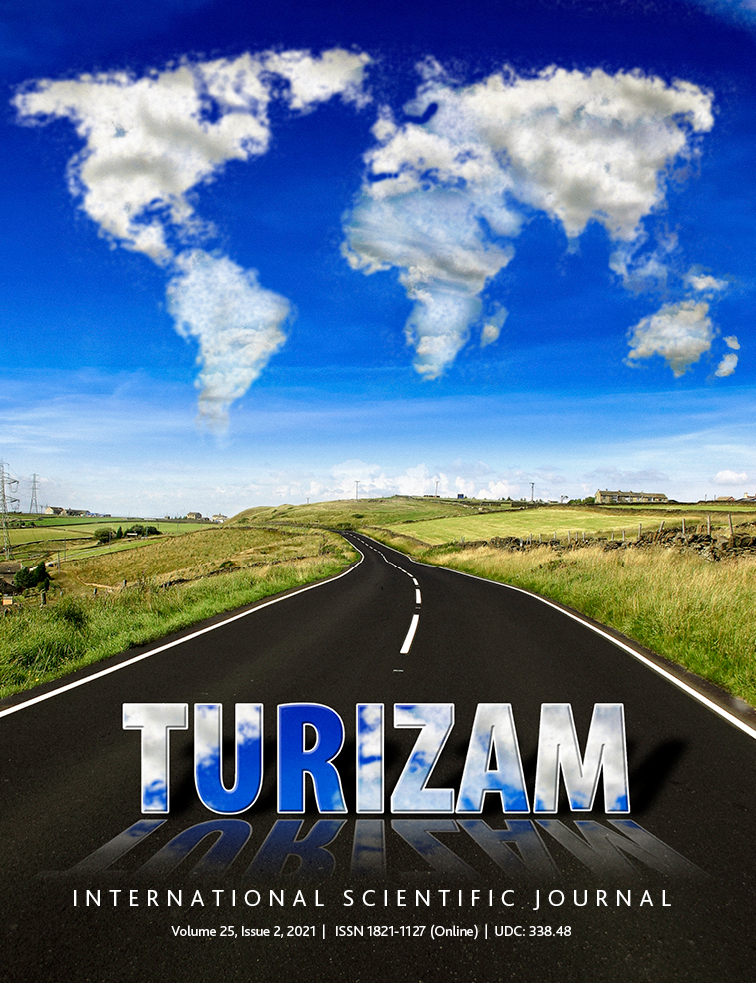Perceptions of “Srem Folk Fest” Participants According to Cultural Tourism Preferences
Abstract
Abstract
“Srem Folk Fest” became one of the most popular and significant international folklore festivals in this part of the Balkan, since 2004. For past 16 years, Sremska Mitrovica was a host city for European, Asian, South American and African youth. Besides its historical importance, this city on the Sava river could also be considered as promoter of culture, tradition and folklore of its guests. Each year, the artistic stylization of folklore stage is accompanied by about 20.000 visitors during the four festival nights. In 2015, “Srem Folk Fest” was added to the calendar of events of the International Council of Organizations of Folklore Festivals and Folk Arts (CIOFF). The Festival is also recognized by the Serbian National Commission for UNESCO as the keeper of the intangible cultural heritage. One of the main tasks of the paper is related to the need of considering potential and participants’ intentions to repeat their visits, as well as of improving the offer and promotion of the city and its surroundings. The aim of the paper is to analyze the data obtained in the context of the behavior and preferences of participants/respondents, to determine the specificity of their role and thus to make a recommendation for creating even better offer. The study obtained the survey research, while gained results might provide a good basis for further organization in accordance with their expectations. In addition, the results could also find practical implication in terms of providing basic information necessary to expand this event within the surrounding area of Sremska Mitrovica.
References
- Agapito, D., Oom Do Valle, P., Mendes, J. C. 2011. Understanding tourist recommendation through destination image: a chaid analysis. Tourism & Managenent studies 7, 33-42.
- Apostolakis, A. 2003. The convergence process in heritage tourism. Annals of Tourism Research Vol. 30, No. 4, 795–812.
- Arcodia, C., Whitfort, M. 2006. Festival Attendance and the Development of Social Capital. Journal of Convention & Event Tourism 8(2), 1-18.
- Besermenji, S., Pivac, T., Wallrabenstein, K. 2010. Attitudes of experts from Novi Sad on the use of the authentic settings of the Petrovaradin fortress as the venue for the EXIT festival. Geographica Pannonica Vol. 14(3), 92-97.
- Bjeljac, Ž. 2006. Teorijsko-metodološke osnove manifestacionog turizma. Srpska akademija nauka i umetnosti, Geografski institute “Jovan Cvijić”. Beograd
- Bjeljac, Ž., Ćurčić, N. 2005. Ethnographic Events in Vojvodina as Part of Tourist Offer. Geographica Pannonoca 9, 59-64.
- Elgammal, I. 2012. The experience of organizing folklore festivals: the case of Ismailia International Folklore Arts Festival IIFAF). Tourism Today, Fall 2012, 8-24.
- Iordache, C. M., Popa R. M. 2008. Cultural – folklore events – promoters of the cultural tourism. Revista de Turism 6, 56-60.
- Jeremić, M. 2016. Sirmium – grad na vodi; razvoj urbanizma i arhitektura od I do VI veka. Arheološki institut, Beograd.
Material given by organizers (the festival director)
- Milisavljević, M., Maričić B., Gligorijević M. 2005.Osnovi marketinga, Centar za izdavačku ekonomskog fakulteta u Beogradu, Beograd.
- Niemčić, I., Zebec, T. 2018. Sustainability of tradition: The case of the International Folklore Festival in Zagreb. In: Özbilgin, M. Ö. and Mellish L. The Cultural Development of Folk Dance Festivals and the Sustainability of Tradition. Ege University Press, İzmir, 213-218.
- Nikolić, S. 2011. Festivali folklora kao način prezentacije nematerijalnog kulturnog nasleđa u funkciji razvoja kulturnog turizma u BIH. GEM 75/1, 155-174. http://www.anthroserbia.org/Content/PDF/Articles/633b650d89724897a374cf2bff9e711 d.pdf (11.01.2020).
- Pavković, V. 2018. Dimenzije nacionalne kulture kao faktor oblikovanja ponašanja i preferencija turista. Turističko poslovanje. 22, 71-80.
- Pavluković, V., Armenski, T., Alcantara-Pilar, J. M. 2017. Social impacts of music festivals: Does culture impact locals’ attitude toward events in Serbia and Hungary? Tourism Management 63, 42-53.
- Pearce, D. 1988. Tourism time budgets. Annuals of Tourism Research, 15(1), 106–121.
- Richards, G., Wilso, J. 2004. The Impact of Cultural Events on City Image: Rotterdam, Cultural Capital of Europe 2001. Urban Studies 41/10, 1931-1951.
- Samardžić, P. 2013. “Srem Folk Fest” – decenija. Sunčani sat, XXI (21), 119-123.
- Stamenković, I., Pivac, T., Blešić, I., Besermenji, S. 2013. Festival Branding – Case study: The Dragačevo Trumpet Festival in Guča. Turizam 17/1, 29-37.
- Uysal, M., Gahan, L., Martin, B. 1993. An examination of event motivations: a case study. Fest Mgmt & Event Tour 1, 5-10.
- Zakić, L., Ivkov-Džigurski, A., Ćurčić, N. 2009. Interaction of foreign visitors of the EXIT music festival with domestic visitors and local population. Geographica Pannonica Vol. 13(3), 97-104.
- Internet 1: http://www.sremfolkfest.org.rs, (05.01.2020),
- Internet 2: Cultural Context of a CIOFF Festival (10.01.2020),
- Internet 3: http://www.cioff-serbia.org, (05.01.2020);
- Internet 4: Annual report (11.01.2020), http://www.cioff.org/documentation/CIOFF%20Annual%20Report%202015.pdf,
- Internet 5: http://www.cioff.org, (05.01.2020).

